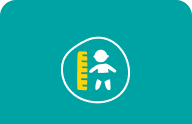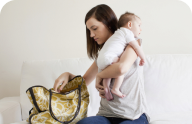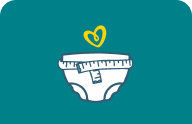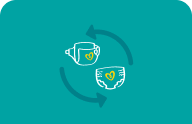When Do Babies Start Crawling?
Every day you watch your baby grow, learn, and become more independent. So it's natural to wonder when your little one will start to crawl. Observing and helping your baby master this new skill is one of the joys of parenting you'll experience in this first year, and the moment your little one “gets it” is one you’ll remember for a long time. Read on to discover the answers to your questions, such as, “When do babies learn to crawl?” and “How old are babies when they crawl?” and learn how to spot the signs that your baby will crawl soon, how to encourage them, the different crawling styles, and what to do if your baby doesn’t crawl as expected.
At What Age Do Babies Crawl?
Many babies learn to crawl sometime between 7 months and 10 months. But as every baby is unique, your little one might be on the move earlier or later than others. Some babies skip the crawling stage altogether.
So, if you’re wondering when “should” babies crawl or what’s a normal crawling age for babies, keep in mind that all babies grow and develop at their own pace. Try not to compare your little one to other babies. If you’re wondering whether your baby is on track, consult your healthcare provider.
Baby Development Milestones Watching how your baby grows and develops is an important part of parenthood. Keep track of your little one's progress with our articles! Learn more
Signs Your Baby Is Getting Ready to Crawl
Before your baby can begin crawling, they’ll need to develop a complex set of skills, all of which will help strengthen your baby's muscles in preparation for crawling.
These are some of the things you might notice your baby doing as they get ready to start crawling:
Constantly moving while lying down
Arching their neck to look around when they’re on their stomach (while you give them supervised tummy time)
Grabbing their feet while they’re lying on their back
Turning or rolling over when they’re lying on their back
Rocking on their hands and knees when they’re on all fours
Pushing themselves backward instead of forward when they’re on all fours
Digging in with their knees and launching forward when they’re on all fours.
At this point in your baby's development, crawling might not be too far off, so make sure you keep a watchful eye on them. Don’t leave them unattended unless they’re in a safe place like their crib.
If you haven't done so already, this is also a great time to babyproof your home. As part of this process, make sure that dangerous items are locked away and that furniture that can tip over is secure, so that your little one can't get in harm’s way once they can move independently.
How to Help Encourage Your Baby to Crawl
Babies are eager to move and explore, and they essentially teach themselves to get where they want to go. But how can you help your baby learn to crawl? To encourage your baby to start crawling, try these ideas:
Place one of your baby’s favorite objects or toys just out of reach in front of them when they’re on the floor to inspire them to start crawling toward it.
Set up an obstacle course for them with pillows, boxes, and other safe objects to help them practice and develop their abilities.
Encourage your baby to crawl toward one of their favorite objects by showing them that you’ve hidden it behind a pillow a little distance from where they are on the floor.
The aim of these exercises is to get your baby excited about learning to crawl and see it as a new adventure. If you feel they’re starting to lose interest or are getting frustrated, it's time to stop and do something else.
Always supervise your baby when they’re playing on the floor and when they’re on their tummy.
Toys to Help Your Baby Crawl
You don’t need to use any specific type of toy to help encourage crawling. As we mentioned above, simply using your baby’s favorite toy and placing it at a short distance in front of them to encourage forward movement may be enough. You could even try toys that make different noises, such as rattles, to pique your little one’s interest.
What Are the Different Crawling Types?
You might be surprised to learn that there is not just one way to crawl—but many! Here are some of the most common types of crawls that you may notice your baby trying as they explore movement:
Classic crawl. Your baby crawls on their hands and knees, moving one arm and the opposite knee forward simultaneously.
Bear crawl. Your baby walks on their hands and feet, keeping their elbows and knees straight.
Belly crawl. Your baby slithers around on their belly while moving forward. This is also known as the army crawl.
Bottom scoot. Your baby moves forward using their arms while scooting on their bottom.
Crab crawl. Your baby moves either backward or sideways with the help of their hands.
Rolling crawl. Your baby moves around by rolling from one place to the next.
Your baby may use any one of these styles or even invent their own, so don’t be worried if their crawling doesn't look like any of those listed above.
What If Your Baby Doesn’t Crawl as Expected?
Just like every other baby, your little one is developing at their own pace and on their own timeline. Try not to think in terms of “my baby should have started to crawl by now.” Also, remember that your baby might not crawl exactly how you expect them to. Instead, they may use another way to get around, such as bottom scooting or belly crawling. Or they may skip crawling altogether.
Usually, there’s no cause for concern as long as your baby is learning how to coordinate their arms and legs. Their eventual goal is to learn how to walk, so try not to focus on how they’re crawling in the meantime.
Of course, if you feel your baby is not moving properly, is unable to coordinate each side of their body, or is not using each arm and leg equally, talk to your healthcare provider. And reach out to your provider any time you have questions or concerns about your baby's development in general.
What If Your Baby Is Crawling Backwards?
When infants start crawling, it’s not unusual for them to crawl backward as they learn how to coordinate their arms and legs. While this may be frustrating for your little one, it’s completely normal and they’ll soon figure it out.
What If Your Baby Is Crawling With One Leg?
If you notice that your little one is only using one side of their body as they crawl, and consistently neglecting the other arm or leg, you should contact your healthcare provider for more advice. It’s also important to ensure your baby attends all their well-child visits.
Stages of Crawling
Every baby learns to crawl in their own unique way, and some even skip crawling completely and go straight to cruising. So there are no set stages when learning to crawl; however, here are some skills and stages that may lead to crawling and beyond:
Rolling over. Around 4 to 6 months, your baby may start to be more physically active. You may notice them rolling over and starting to sit upright without much support.
Creeping. Before your baby uses their hands and knees to crawl, they may creep which involves pushing themselves along on their bellies. This is simply a form of crawling.
Crawling. Around 7 to 10 months, you may notice your baby trying different types of crawling styles as they learn how to move around and explore their environment.
Cruising. As your baby’s arms and legs get stronger, they will pull themselves up to standing and may start taking small steps while holding on to furniture. This is all in preparation for taking those first amazing steps by themselves.
Remember that every child reaches milestones at their own rate, so these stages are simply a general guide. It’s important to be patient and gently encouraging with your little one as they learn new skills.
If you have any concerns about your baby’s development, contact your healthcare provider for more advice, and be sure your baby attends all their well-child checkups.
How to Keep Your Baby Safe When Crawling
Crawling opens up a whole new world for your baby! But that means it’s time to babyproof your home and keep an extra close eye on your little one. To keep your baby safe when they start crawling, take these precautions to prevent injuries and ensure their environment is safe:
Babyproof the environment:
Install safety gates at the top and bottom of stairs to prevent falls
Secure heavy furniture and appliances to the wall to prevent them from tipping over if your baby pulls up on them
Use corner and edge bumpers on furniture with sharp edges
Keep small objects, such as coins, buttons, and small toys, out of reach to prevent choking
Cover electrical outlets
Keep electrical cords, blind cords, and curtain ties out of reach to prevent strangulation hazards
Keep hazardous substances out of reach.
Supervise Your Baby:
Always keep an eye on your baby while they are exploring their environment. Even a momentary lapse in supervision can lead to accidents
Create a designated safe area for your baby to crawl and explore. Use playpens or gated areas to limit access to unsafe parts of your home
Encourage your baby to explore safely and teach them to avoid dangerous areas, such as the kitchen or bathroom, without supervision.
What to Do If Your Baby Is Not Crawling
As we mentioned earlier in the article, reaching the crawling milestone can happen at different times for each child. Although the average age for learning to crawl is between 7 and 10 months, don’t worry if your baby is 8, 9, or 10 months old and not crawling—this may happen later for them. And if you’re wondering “Do some infants skip crawling?” the answer is yes—some children skip this step entirely before learning to stand and walk. This is completely normal.
Contact your healthcare provider if you have any concerns about your child’s development or movement, and ensure that your baby sees their healthcare provider for all of their well-child visits.
The Bottom Line
Crawling lets your baby see and explore his world in a new and different way, and they’ll love this expanded freedom and mobility. In time, they’ll be ready for more and want to join in with everyone else who is walking. Enjoy this special time. Crawling is a new adventure for your baby, and in its own way, your baby moving independently is a new adventure for you as a parent, too.
To start earning points on all those diaper purchases, download the Pampers Club app today.
How We Wrote This Article The information in this article is based on expert advice found in trusted medical and government sources, such as the American Academy of Pediatrics and the American College of Obstetricians and Gynecologists. You can find a full list of sources used for this article below. The content on this page should not replace professional medical advice. Always consult medical professionals for full diagnosis and treatment.
Join a World of Support
through Pregnancy and Parenthood.
TRACK WITH TOOLS
LEARN WITH EXPERTS
GET REWARDED












